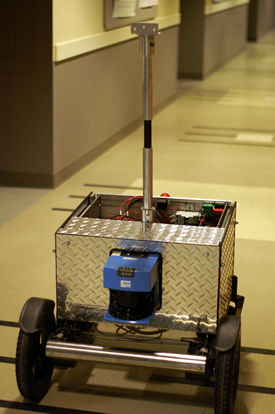
 |
| A group of engineering students is working to turn a converted wheelchair into an unmanned vehicle that can navigate a course in the Intelligent Ground Vehicle Competition that will be held at Oakland University May 30 through June 2. |
By Rebecca Wyatt Thomas, OU Web Writer
A group of engineering students is working to turn a converted wheelchair into an unmanned vehicle that can navigate a course in the Intelligent Ground Vehicle Competition that will be held at Oakland University May 30 through June 2. The international competition will feature robots from various universities that move independently on an increasingly more difficult course located in the field at the corner of Walton and Adams roads.
The team of eight students, including graduate and undergraduate computer science, electrical engineering students and systems engineering students are using what they have learned in their studies to create a competitive robot.
The group inherited the frame from last year’s OU competitors but the students weren’t happy with the drive control system and wanted to construct something with a pure differential drive system. They took a wheelchair and converted it to meet their needs.
“It doesn’t look like a wheelchair. All that is left is the very basic structure,” said Oakland Robotics Association President Micho Radovnikovich. The robot is smaller and more compact that OU’s robot from last year, with a drawer for the electronics and a touch-screen monitor.
Last year’s group was unable to compete because the robot was not complete at the time of the competition. This year, the team has been working for a few months to build the robot and will now move into the testing phase. Now that the groundwork for the robot is completed, each year, the team can build from the original concept.
“Last year I was able to go and see what the other schools in the competition were doing. As a team, we were able to look at some design reports and try to imitate the things that worked. Where we noticed weaknesses we tried to improve upon them,” Radovnikovich said. “It’s been a long road though. Other schools were testing and we’re still building our robot from scratch. The people on are team are working really hard. Whenever we set a target, we are going to complete it before we sleep.”
More than 48 teams are signed up to participate in the IGVC. Radovnikovich expects the team to do well this year, and even better next year.
The robots autonomously navigate a course that will be set up in the open area at the corner of Walton and Adams road. A white line will be on the ground. The robot must be able to look for intensity differences, use range finders and other programs to navigate the path, which will get more difficult as the competition goes on.
Radovnikovich said working on the robot has provided the students with an education they can’t get in the classroom.
“This experience is really good on a resume. We are taking a real application from start to finish. The knowledge we learn can be applied in a lot of places, in robotics, in military applications and many other areas,” Radovnikovich said.
All of the students are volunteering their time to make the robot competitive.
“Whatever we learn in the classroom, we are applying in real time,” said Pavan Vempady, vice president of the OU Robotics Association. “But we like the work. If you like the work, it’s just like playing. And when something starts to work, it’s one of the most fun things you’ve ever done.”
Vempady encourages students interested in engineering and research to get involved. He said students can be trained and most easily pick up the concepts, which reinforce what they have learned in class. Students are also needed to help work on the documentation portion of the project.
While the students are putting in the labor, the School of Engineering and Computer Science allows them to use the school’s equipment to work on the robot and also supports the organization. The Chrysler Foundation also provided support and additional funding for the robot comes from the Student Activities Funding Board.
The IGVC is free and open to the public. For more information visit the Intelligent Ground Vehicle Competition Web site.
 A group of engineering students is working to turn a converted wheelchair into an unmanned vehicle that can navigate a course in the Intelligent Ground Vehicle Competition that will be held at Oakland University May 30 through June 2. The international competition will feature robots from various universities that move independently on an increasingly more difficult course located in the field at the corner of Walton and Adams roads. The team of eight students, including graduate and undergraduate computer science, electrical engineering students and systems engineering students are using what they have learned in their studies to create a competitive robot.
A group of engineering students is working to turn a converted wheelchair into an unmanned vehicle that can navigate a course in the Intelligent Ground Vehicle Competition that will be held at Oakland University May 30 through June 2. The international competition will feature robots from various universities that move independently on an increasingly more difficult course located in the field at the corner of Walton and Adams roads. The team of eight students, including graduate and undergraduate computer science, electrical engineering students and systems engineering students are using what they have learned in their studies to create a competitive robot.